For affiliate marketers, one of the biggest questions is — mobile vs desktop web traffic? Each type of traffic has its pros and cons and a successful campaign depends on whether you can determine which source is better for your product and target audience. On one hand, mobile traffic is bigger and wider but on the other hand desktop traffic often gives higher conversions for certain niches. In affiliate marketing, understanding the pros and cons of mobile or desktop traffic can help you build smarter funnels and choose the right ad formats.
In this article from ROIads ad network team, we will go through the key differences, pros and cons of each source of traffic and help you choose the right strategy for your campaigns.
Traffic Statistics: Mobile vs Desktop Usage
In 2024, the internet landscape is shifting heavily towards mobile devices. With the rapid increase of mobile device adoption and internet access worldwide the percentage of mobile users vs desktop users has reached new highs. Recent traffic analytics studies show that over 60% of global internet traffic comes from mobile devices and 40% from desktops. The ongoing debate of web traffic mobile vs desktop isn’t just about numbers — it’s about behavior, engagement, and conversions.
Traffic Comparison: Desktop vs Mobile Devices
When it comes to traffic, one of the main differences between mobile and desktop users is their behavior on the site. In affiliate marketing context understanding these differences is crucial for choosing the right ad formats, optimizing landing pages and building conversion funnels.

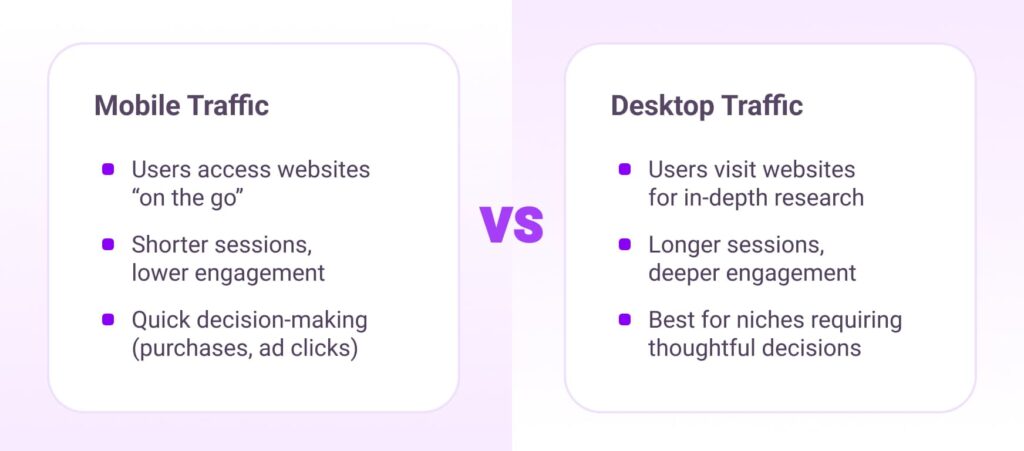
The Advantages of Mobile Traffic
Mobile users typically access websites while “on the go.” They make quick decisions whether to buy a product or click on an ad. But their sessions are shorter and engagement is lower.
One of the key features of mobile traffic is its volume and immediacy. Mobile users are more impulsive and can be engaged through advertising formats like push notifications, which deliver quick, direct messages to their devices, or other action-driven campaigns. Mobile traffic is ideal for verticals that rely on fast decision-making.
The Advantages of Desktop Traffic
On the other hand, desktop users visit websites to research more in-depth. They spend more time exploring products or services and are good for niches that need more thoughtful purchase decisions. That’s one of the key advantages of desktop traffic — it gives you more time to convince users and walk them through your funnel.
Desktop traffic stands out for its longer user sessions and deeper engagement. People using desktops tend to spend more time researching, which means they’re more likely to explore multiple pages before making a decision. This naturally leads to more page visits and gives them the time to fully understand your offer before converting.
Main differences in desktop and mobile user behavior:
- Time on site: Desktop users spend more time on site so you can hold attention and have more opportunities to sell.
- Pages per session: Desktop users visit more pages.
- Bounce rate: Mobile traffic has a higher bounce rate due to slow page load and navigation issues.
| Metric | Desktop Users | Mobile Users |
| Average time on site | 5 minutes | 2.5 minutes |
| Pages per session | 3.2 | 1.7 |
| Bounce rate | 35% | 52% |
The above comparison shows clear behavioral differences in internet traffic mobile vs desktop, which should guide your optimization strategies. When choosing between mobile and desktop traffic, it’s essential to also consider which ad formats work best on these devices. Push and pop traffic, two of the most effective formats, offer excellent visibility and high conversion potential depending on the user’s behavior and device.
How to Reduce Bounce Rate on Desktops and Mobile
A high bounce rate is not just a mobile problem, it’s a problem on desktops too. While mobile traffic is more prone to high bounce rates due to adaptation and speed issues, desktop traffic can also have high bounce rates if the user experience doesn’t meet audience expectations.
Reasons for High Bounce Rates on Desktops:
- Slow page load: While desktop users may be more patient, load time is still a big factor. If pages load slow, users lose interest and leave the site. This is especially true for heavy sites with lots of graphics or scripts that can slow down the site.
- Complex navigation: Desktop users expect an easy to navigate interface where they can find what they need quickly. If the navigation is too complex or confusing, users will leave without spending time searching.
- Overloaded pages: On larger desktop screens, many sites try to put as much information as possible. But this can overwhelm users, especially if the site is filled with pop-ups, banners or too many visual elements.
- Outdated design: Desktop users can be more demanding when it comes to the website’s look. Outdated or poorly maintained design creates distrust and users will leave the site.
How to reduce bounce rate on desktops:
Minimize graphics and scripts to reduce load time, and ensure fast server performance. Make navigation simple and intuitive so users can find what they need easily. Use screen space wisely, highlight CTA buttons and don’t clutter the content. Update your site design regularly to meet modern UX standards so it looks professional and up-to-date. Control pop-ups and minimize their use to not disrupt the user experience.
Reasons for High Bounce Rates on Mobiles:
- Slow page load: Mobile users expect instant content. If a site takes more than a second to load, they will leave without waiting for the full page to load. This is especially true for campaigns using push notifications or time sensitive offers where delays can kill engagement.
- Bad navigation: Mobile screens are small and users expect a simple and intuitive interface. If the navigation is hard or requires extra actions like constant zooming or scrolling, users will leave fast.
- Bad content adaptation: Landing pages not optimized for mobile devices may display text or images incorrectly. This can cause user frustration and they will leave the site without interacting with it.
How to reduce bounce rate on mobile:
Reduce load time by having the page load in 2-3 seconds, use lightweight images and minimal scripts. Optimize landing pages for mobile screens: navigation should be simple, buttons big and text easy to read. Simplify forms — the less fields to fill out the higher the conversion rate. Do A/B testing on different versions of landing pages to find out what works best for design and creatives.
Pop and push traffic: On which devices works better?
In 2024 pop and push traffic remain one of the best sources in affiliate marketer’s arsenal. It’s because of their high visibility, wide audience coverage and ability to drive fast and quality conversions.
When media buyers work with pop and push traffic, it’s important to consider which verticals and geo’s bring the most conversions per device. Different devices require different approaches and understanding how users interact with ads on mobile and desktop devices helps to increase campaign performance. In this section we will share how these traffic sources work in ROIads — we will break down top geo’s, verticals and nuances of each of these sources.
Push: Top Geos and Verticals
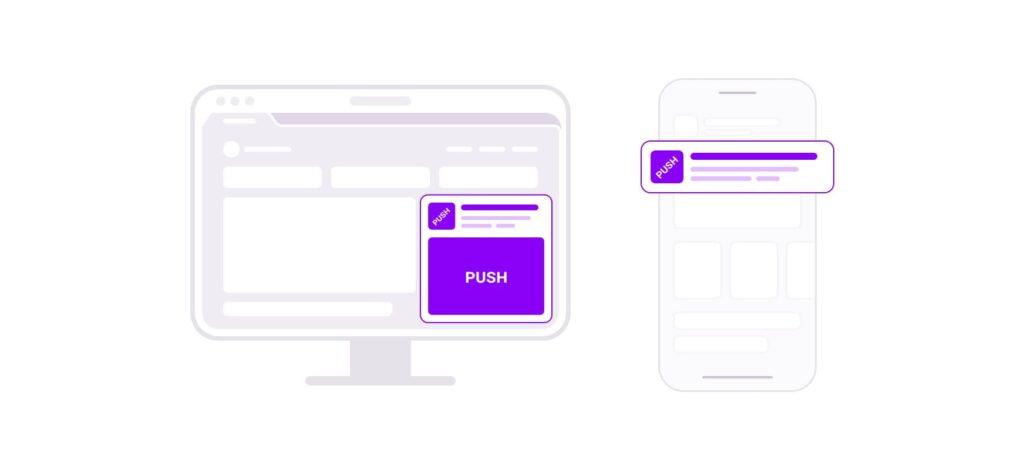
Push notifications are a universal format that works well on both mobile and desktop devices.
- On mobile, push shows good results in verticals like gambling, betting, finance, dating, antivirus, sweepstakes and nutra. These verticals win big from instant delivery and high visibility of push notifications. Mobile users make decisions fast, that makes push perfect for promotions, bonuses or exclusive offers that encourage them to take action now.
- On desktop, push works in verticals like gambling, betting, finance, dating, antivirus, sweepstakes. But here they work on a more conscious interaction. Desktop users take more time to study offers, that makes push to be a reminder of good conditions or offers. In these verticals desktop push is perfect for re-visit and conversion actions like registration or purchase.
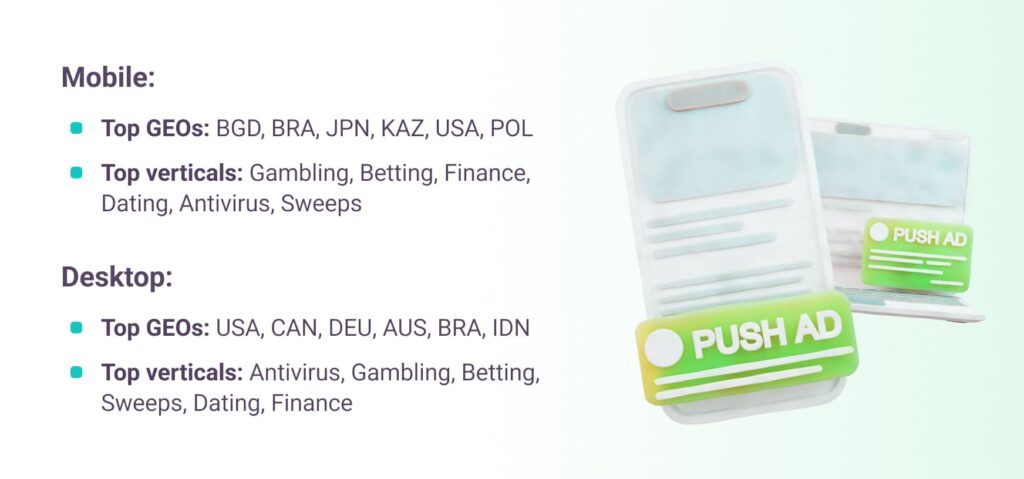
Pops: Top Geos and Verticals
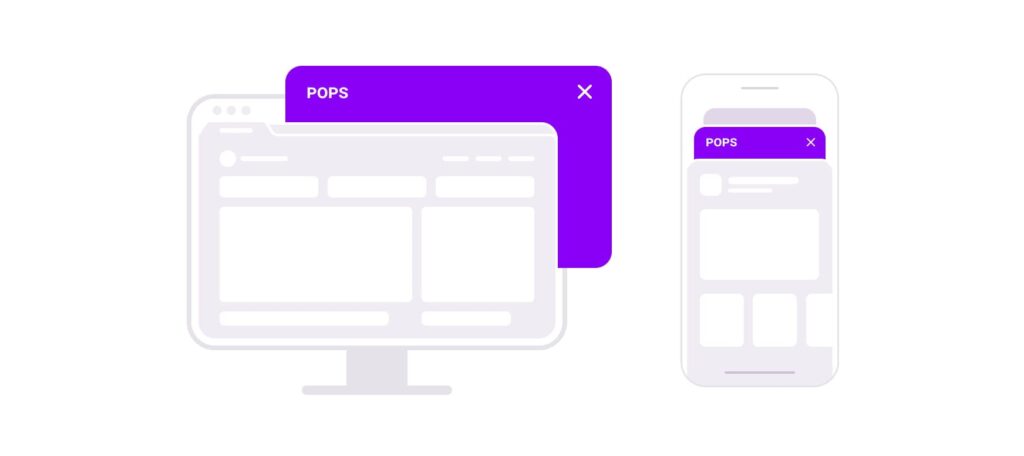
Popunders (pops) are a great advertising tool on both mobile and desktop devices, especially in verticals where traffic volume and audience coverage is important.
- On mobile, pops work well in verticals like gambling, betting, finance, telecom, sweepstakes and dating. These verticals use pops to drive users to special offers and promotions. For example, in telecom vertical pops can offer users a good tariff plan or mobile service and encourage them to visit the site. For gambling and betting, pops attract attention to bonuses and promotions and encourage users to play or make a bet.
- On desktop, pops show good results in verticals like gambling, betting, e-commerce and dating. Desktop users spend more time in front of the computer and can interact with pops without annoyance. For example, in e-commerce vertical pops promote discounts and exclusive offers and encourage users to complete purchases. In dating and gambling verticals desktop pops can attract attention to new offers or bonuses and encourage users to register or come back to the platform.
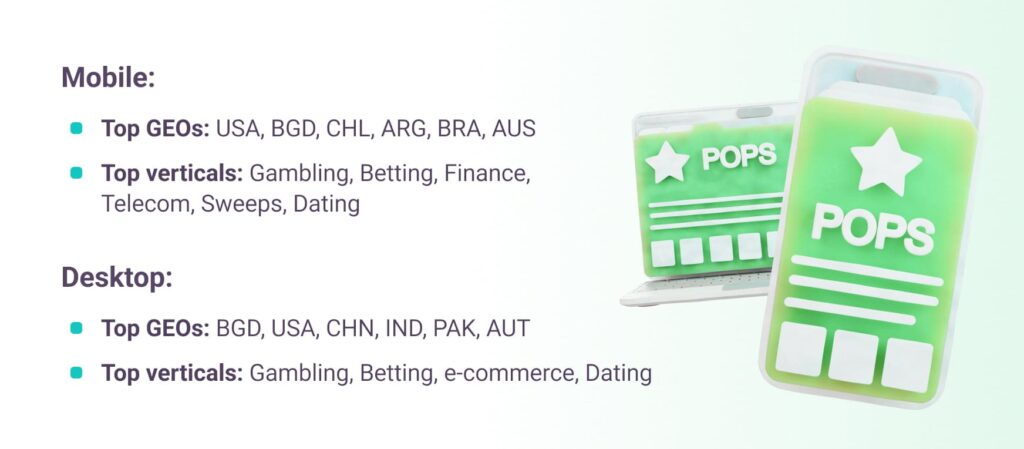
Want to run a successful campaign on mobile or desktop traffic? ROIads has the tools for pop and push formats. Let’s see how our advertising platform can help you.
ROIads Overview
- Reach: More than 9.6 billion impressions every month.
- Geography: Covers 150+ countries worldwide.
- Ad Formats: Focuses on Pop and Push ads.
- Platform Features: AI-Bidding Technology, Micro Bidding, access to premium traffic sources, a dedicated account manager, customizable blacklists and whitelists, and exclusive creatives available upon request.
Traffic Volume by Device and Ad Format in ROIads
| Ad Format | Device Traffic (Impressions) |
| Mobile Push | 720M |
| Desktop Push | 107M |
| Mobile Pop | 3.2M |
| Desktop Pop | 1.6M |
In our ad network, you can launch campaigns across various formats with significant traffic volumes. For detailed traffic analysis by geo, along with comprehensive data on CPC, CPM, and impressions, visit the Insights tab after registering on the ROIads platform.
Conclusion
In the world of affiliate marketing, choosing between mobile users vs desktop users is an essential and ongoing question. Both have their own advantages that can make or break your campaign depending on your audience and vertical. Mobile traffic is the volume and immediacy winner, so perfect for campaigns that need instant engagement and quick conversions. Desktop traffic is the go-to for verticals that need deeper engagement, research and higher value conversions.
Mobile or desktop, quick-action or high-conversion funnels, ROIads has got you covered. With our experience in pop and push traffic, advanced AI bidding technology and global reach we’ll help you get the right traffic to get real results. No matter which side wins the traffic mobile vs desktop argument, the smartest marketers are the ones who test both and let data decide. Start your campaigns now and see how you can use both mobile and desktop traffic to your advantage.





